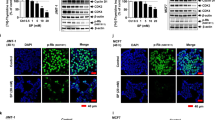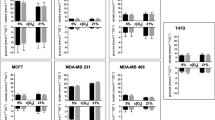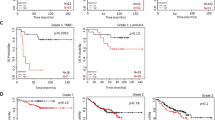Abstract
Introduction
Short-chain fatty acids (SCFAs) are ubiquitous lipids produced as a result of bacterial fermentation of dietary fiber. While their role in colorectal cancer is well known, the effect of SCFAs in breast cancer is poorly defined.
Objective
To understand the various effects of SCFAs on breast carcinogenesis, we investigated the effect of sodium butyrate (NaB) and sodium propionate (NaP) in MCF-7 cell line.
Materials and methods
Cells were incubated with different concentrations of NaB or NaP for 24, 48, 72 or 96 h. Cell proliferation was assayed using MTT kit. Cell cycle was performed using propidium iodide staining then analyzed with a flow cytometer. Apoptosis was assessed by Hoechst technique and cell-cycle sub-G1 phase.
Results
NaB and NaP inhibited MCF-7 cell proliferation in a dose-dependent manner with respective IC50 of 1.26 mM and 4.5 mM, thus indicating that NaB is more potent than NaP. Low and medium levels of both SCFAs induced morphology changes which are characteristic of a differentiated phenotype. Flow cytometry analysis revealed a blockage in G1 growth phase. Interestingly, removing NaB or NaP from culture media after few days of treatment showed a reversible effect on cell morphology and proliferation where cells reentered the cycle after 24 h of drug wash-out. Finally, treatment with medium levels of these molecules induced low MCF-7 apoptosis, while higher doses led to massive apoptosis.
Conclusion
Our results show that SCFAs may be considered as an interesting inhibitor for breast cancer progression.







Similar content being viewed by others
References
Sealy L, Chalkley R. The effect of sodium butyrate on histone modification. Cell. 1978;14:115–21.
Davie JR. Inhibition of histone deacetylase activity by butyrate. J Nutr. 2485S;133:2485S–S24932493.
Wang Y, Hu PC, Ma YB, Fan R, Gao FF, Zhang JW, et al. Sodium butyrate-induced apoptosis and ultrastructural changes in MCF-7 breast cancer cells. Ultrastruct Pathol. 2016;40:200–4.
Pant K, Yadav AK, Gupta P, Islam R, Saraya A, Venugopal SK. Butyrate induces ROS-mediated apoptosis by modulating miR-22/SIRT-1 pathway in hepatic cancer cells. Redox Biol. 2017;12:340–9.
Mahadevan V. HDAC inhibitors show differential epigenetic regulation and cell survival strategies on p53 mutant colon cancer cells. J Biomol Struct Dyn. 2018;36:938–55.
Han R, Sun Q, Wu J, Zheng P, Zhao G. Sodium butyrate upregulates miR-203 expression to exert anti-proliferation effect on colorectal cancer cells. Cell Physiol Biochem. 2016;39:1919–29.
Ma J, Zhang Y, Wang J, Zhao T, Ji P, Song J, et al. Proliferative effects of gamma-amino butyric acid on oral squamous cell carcinoma cells are associated with mitogen-activated protein kinase signaling pathways. Int J Mol Med. 2016;38:305–11.
Khan MA, Ahmad R, Srivastava AN. Effect of methyl butyrate aroma on the survival and viability of human breast cancer cells in vitro. J Egypt Natl Canc Inst. 2016;28:81–8.
Damaskos C, Garmpis N, Valsami S, Kontos M, Spartalis E, Kalampokas T, et al. Histone deacetylase inhibitors: an attractive therapeutic strategy against breast cancer. Anticancer Res. 2017;37:35–46.
Huang W, Ren C, Huang G, Liu J, Liu W, Wang L, et al. Inhibition of store-operated Ca(2+) entry counteracts the apoptosis of nasopharyngeal carcinoma cells induced by sodium butyrate. Oncol Lett. 2017;13:921–9.
Abe M, Kufe DW. Effect of sodium butyrate on human breast carcinoma (MCF-7) cellular proliferation, morphology, and CEA production. Breast Cancer Res Treat. 1984;4:269–74.
Kim J, Park H, Im JY, Choi WS, Kim HS. Sodium butyrate regulates androgen receptor expression and cell cycle arrest in human prostate cancer cells. Anticancer Res. 2007;27:3285–92.
Siavoshian S, Blottiere HM, Cherbut C, Galmiche JP. Butyrate stimulates cyclin D and p21 and inhibits cyclin-dependent kinase 2 expression in HT-29 colonic epithelial cells. Biochem Biophys Res Commun. 1997;232:169–72.
Glass KA, McDonnell LM, Rassel RC, Zierke KL. Controlling Listeria monocytogenes on sliced ham and turkey products using benzoate, propionate, and sorbate. J Food Prot. 2007;70:2306–12.
Yoon SK, Ahn Y-H. Application of sodium propionate to the suspension culture of Chinese hamster ovary cells for enhanced production of follicle-stimulating hormone. Biotechnol Bioprocess Eng. 2007;12:497.
El Boustany C, Bidaux G, Enfissi A, Delcourt P, Prevarskaya N, Capiod T. Capacitative calcium entry and transient receptor potential canonical 6 expression control human hepatoma cell proliferation. Hepatology. 2008;47:2068–77.
El Boustany C, Katsogiannou M, Delcourt P, Dewailly E, Prevarskaya N, Borowiec AS, et al. Differential roles of STIM1, STIM2 and Orai1 in the control of cell proliferation and SOCE amplitude in HEK293 cells. Cell Calcium. 2009;47:350–9.
Katsogiannou M, El Boustany C, Gackiere F, Delcourt P, Athias A, Mariot P, et al. Caveolae contribute to the apoptosis resistance induced by the alpha(1A)-adrenoceptor in androgen-independent prostate cancer cells. PLoS ONE. 2009;4:e7068.
Al-Dhaheri M, Wu J, Skliris GP, Li J, Higashimato K, Wang Y, et al. CARM1 is an important determinant of ERalpha-dependent breast cancer cell differentiation and proliferation in breast cancer cells. Cancer Res. 2011;71:2118–28.
Zhang Z, Lei A, Xu L, Chen L, Chen Y, Zhang X, et al. Similarity in gene-regulatory networks suggests that cancer cells share characteristics of embryonic neural cells. J Biol Chem. 2017;292:12842–59.
Cummings BS, Schnellmann RG. Measurement of cell death in mammalian cells. Curr Protoc Pharmacol. 2004;12:12–8.
McMichael AJ, Potter JD. Dietary influences upon colon carcinogenesis. Princess Takamatsu Symp. 1985;16:275–90.
Jacobs LR. Relationship between dietary fiber and cancer: metabolic, physiologic, and cellular mechanisms. Proc Soc Exp Biol Med. 1986;183:299–310.
Jacobs LR. Effect of dietary fiber on colonic cell proliferation and its relationship to colon carcinogenesis. Prev Med. 1987;16:566–71.
Jacobs R. Role of dietary factors in cell replication and colon cancer. Am J Clin Nutr. 1988;48:775–9.
Wu X, Wu Y, He L, Wu L, Wang X, Liu Z. Effects of the intestinal microbial metabolite butyrate on the development of colorectal cancer. J Cancer. 2018;9:2510–7.
Wang G, Yu Y, Wang YZ, Wang JJ, Guan R, Sun Y, et al. Role of SCFAs in gut microbiome and glycolysis for colorectal cancer therapy. J Cell Physiol. 2019;234:17023–49.
Hinnebusch BF, Meng S, Wu JT, Archer SY, Hodin RA. The effects of short-chain fatty acids on human colon cancer cell phenotype are associated with histone hyperacetylation. J Nutr. 2002;132:1012–7.
West AC, Johnstone RW. New and emerging HDAC inhibitors for cancer treatment. J Clin Investig. 2014;124:30–9.
Goey AK, Sissung TM, Peer CJ, Figg WD. Pharmacogenomics and histone deacetylase inhibitors. Pharmacogenomics. 2016;17:1807–15.
Eckschlager T, Plch J, Stiborova M, Hrabeta J. Histone deacetylase inhibitors as anticancer drugs. Int J Mol Sci. 2017;18:1414.
Li Y, Peng L, Seto E. Histone deacetylase 10 regulates the cell cycle G2/M phase transition via a novel let-7-HMGA2-cyclin A2 pathway. Mol Cell Biol. 2015;35:3547–65.
Jang YG, Hwang KA, Choi KC. Rosmarinic acid, a component of rosemary tea, induced the cell cycle arrest and apoptosis through modulation of HDAC2 expression in prostate cancer cell lines. Nutrients. 2018;10:1784.
Pattayil L, Balakrishnan-Saraswathi HT. In vitro evaluation of apoptotic induction of butyric acid derivatives in colorectal carcinoma cells. Anticancer Res. 2019;39:3795–801.
Cao M, Zhang Z, Han S, Lu X. Butyrate inhibits the proliferation and induces the apoptosis of colorectal cancer HCT116 cells via the deactivation of mTOR/S6K1 signaling mediated partly by SIRT1 downregulation. Mol Med Rep. 2019;19:3941–7.
Jia X, Zheng Y, Guo Y, Chen K. Sodium butyrate and panobinostat induce apoptosis of chronic myeloid leukemia cells via multiple pathways. Mol Genet Genomic Med. 2019;7:e613.
Taylor MA, Khathayer F, Ray SK. Quercetin and sodium butyrate synergistically increase apoptosis in rat C6 and human T98G glioblastoma cells through inhibition of autophagy. Neurochem Res. 2019;44:1715–25.
Salimi V, Shahsavari Z, Safizadeh B, Hosseini A, Khademian N, Tavakoli-Yaraki M. Sodium butyrate promotes apoptosis in breast cancer cells through reactive oxygen species (ROS) formation and mitochondrial impairment. Lipids Health Dis. 2017;16:208.
Kim K, Kwon O, Ryu TY, Jung CR, Kim J, Min JK, et al. Propionate of a microbiota metabolite induces cell apoptosis and cell cycle arrest in lung cancer. Mol Med Rep. 2019;20:1569–74.
Ryu TY, Kim K, Son MY, Min JK, Kim J, Han TS, et al. Downregulation of PRMT1, a histone arginine methyltransferase, by sodium propionate induces cell apoptosis in colon cancer. Oncol Rep. 2019;41:1691–9.
Acknowledgements
We thank Pr. Hasnaa Bouharoun-Tayoun and Pr. Soulaima Chamat (Lebanese University—Faculty of Public Health Branch 2, Fanar—Lebanon) for allowing us the full access to their laboratory and equipment. This work was supported by a grant from the Lebanese University.
Author information
Authors and Affiliations
Corresponding author
Ethics declarations
Conflict of interest
The authors declare that they have no conflict of interest.
Additional information
Publisher's Note
Springer Nature remains neutral with regard to jurisdictional claims in published maps and institutional affiliations.
Electronic supplementary material
Below is the link to the electronic supplementary material.
12282_2020_1063_MOESM1_ESM.pptx
Supplementary file1 Supplementary figure 1: Effect of NaB or NaP on MCF-7 cell line morphology after 24 h of drug wash-out. The upper panel shows the control cell cycle shape in MCF-7 cells. The middle panel shows cell cycle shape after 24 h of 0.5 mM of NaB wash-out. The lower panel shows cell cycle shape after 24 h of 1 mM of NaP wash-out. Supplementary figure 2: Effect of NaB or NaP on MCF-7 cells morphology. The upper panel shows the control cell cycle shape in MCF-7 cells. The middle panel shows the effect of 72 h treatment with 5 mM NaB. The lower panel shows the effect of 72 h treatment with 10 mM of NaP. (PPTX 871 kb)
About this article
Cite this article
Semaan, J., El-Hakim, S., Ibrahim, JN. et al. Comparative effect of sodium butyrate and sodium propionate on proliferation, cell cycle and apoptosis in human breast cancer cells MCF-7. Breast Cancer 27, 696–705 (2020). https://doi.org/10.1007/s12282-020-01063-6
Received:
Accepted:
Published:
Issue Date:
DOI: https://doi.org/10.1007/s12282-020-01063-6




